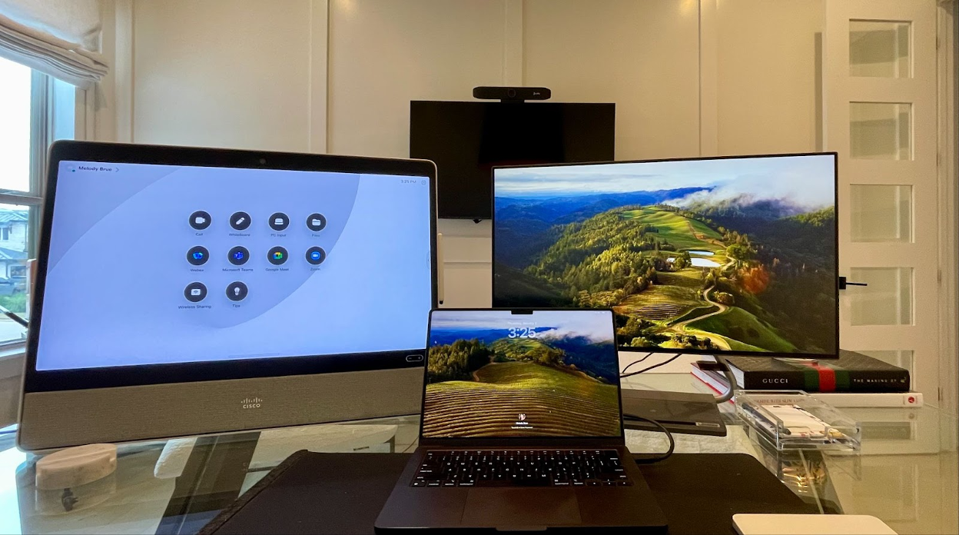
With the explosive growth of hybrid and remote work models in recent years, videoconferencing has become an indispensable tool for businesses. As employees and clients are increasingly dispersed, reliable and user-friendly video collaboration is essential. Companies have embraced a diversified approach to videoconferencing, with the majority employing three or more platforms. This multiplatform strategy allows organizations to leverage the strengths of different tools, but critically, it demands the ability to seamlessly transition among the different platforms on a single device for optimal flexibility and efficiency.
In this context, the Cisco Desk Pro is an all-in-one desktop video collaboration device designed to enhance productivity and connectivity in hybrid work environments. Its adaptability empowers organizations to choose the meeting platforms that best suit their needs while maintaining the flexibility to connect users on different services. With a connected calendar, the Desk Pro makes joining meetings on any platform incredibly easy. Users can join Webex, Microsoft Teams, Google Meet and Zoom meetings with one click.
The Desk Pro can also be deployed with a Webex-centric approach, taking advantage of the “Cisco Rooms” functionality to optimize Webex Meetings and provide advanced cognitive collaboration features. Alternatively, the Desk Pro can be configured as a dedicated Microsoft Teams Rooms system, delivering a native Teams experience with optimized features and interface. While this configuration prioritizes Microsoft Teams, it still allows users to join Webex meetings with full functionality.
How does the Cisco Desk Pro stack up to the needs of today’s hybrid worker? In this review, I will examine the Desk Pro’s features, design, performance and overall value, focusing on its suitability for today’s distributed workforce.
Technical Specifications
- Display: 27-inch 4K (3840 x 2160) touchscreen with anti-glare coating
- Camera: 4K Ultra HD with 12 MP resolution, automatic framing and presenter tracking
- Audio: Integrated speaker system with three directional speakers and a subwoofer, plus an advanced noise-canceling microphone array
- Connectivity: Wi-Fi 6, Bluetooth 5.0, USB-C (with laptop charging capability), HDMI, Ethernet
- Operating System: Cisco Webex OS
- Other features: Integrated whiteboard, digital signage capabilities, proximity sensor
Design And Aesthetics
The Desk Pro has a sleek design suitable for both individual desks and conference rooms. The 27-inch touchscreen is prominent, providing ample space for video conferencing, content sharing and digital whiteboarding. The all-in-one design minimizes cable clutter and simplifies setup. Indeed, it’s clear that the system was designed with easy setup in mind: from opening the box to being fully set up took less than ten minutes once my company’s Webex administrator provided me with an activation code.
In my office, the Desk Pro serves as a third screen alongside my Apple MacBook Air and a Lenovo Qreator 4K UHD 27-inch monitor. With this setup, I can easily participate in meetings on the Desk Pro while accessing other applications and workflows on my other screens. I can also multitask directly on the Desk Pro, which is especially handy for in-meeting collaboration on whiteboards.

User Experience And Performance
The Desk Pro offers a very smooth user experience. The touchscreen is responsive, and the Webex OS provides a familiar interface for organizations already using Cisco’s collaboration ecosystem. The 4K camera delivers excellent video quality, and the automatic framing ensures that all participants are visible. When the auto-brightness feature is engaged, the camera can be slow to adjust to sudden or drastic changes in lighting. However, this feature can also be toggled off, which I recommend if you are using key lights or bright lighting for a presentation or podcast. One standout feature is the camera’s ability to track the user’s movement. This is particularly useful on a long call or when presenting. If I move around within my office, the camera tracks me, allowing me to get up and stretch or stand during a presentation without adjusting the camera. Camera settings can also be adjusted manually for pan, tilt and zoom. A self-view screen in the top right corner allows users to make any adjustments before joining a meeting.
During the WebexOne event in October, I sat down with Snorre Kjesbu, senior vice president and general manager of collaboration devices at Cisco. He explained that the tracking feature minimizes fatigue during long meetings, allowing presenters to stand up and move around naturally. “The Desk Pro reflects our focus on user experience,” Kjesbu said. “It’s designed to help people work more effectively. The minimalist design keeps the technology out of the way, allowing users to stay focused. We believe the Desk Pro is a great example of how thoughtful design can improve the modern workspace.”
With its three directional speakers and subwoofer, the Desk Pro delivers excellent audio quality, making it easy to distinguish voices in large meetings. The advanced noise-canceling microphone array effectively captures voices and minimizes background noise, which is particularly useful in busy environments. Microphone settings include neutral noise removal to eliminate background noise and an “optimize for my voice” feature to remove background noise along with background speech—a handy setting in an open-seating environment or shared workspace.
Collaboration Features
I found that the Desk Pro excels in its collaboration capabilities. For instance, the integrated whiteboard does a good job of facilitating real-time brainstorming. In my experience, this feature significantly improves engagement during online brainstorming sessions compared to traditional screen sharing.
The wireless screen-sharing feature is particularly convenient, and the ability to share content from a laptop or mobile device also enhances productivity during meetings. The Desk Pro also supports digital signage, allowing the display to show company information or announcements when not in use for video conferencing.
IT Management And Security Features
The Desk Pro integrates with Cisco Control Hub, simplifying device management for IT administrators. This allows for remote monitoring, configuration and troubleshooting across multiple locations, streamlining deployment for IT staff and ensuring consistent performance for end users.
The Cisco Desk Pro incorporates robust security measures to protect data and ensure a secure collaboration environment. It encrypts data transmitted during Webex and Microsoft Teams meetings to safeguard information. Access control features, including single sign-on and role-based access control, restrict unauthorized use and maintain privacy. The Desk Pro also benefits from Cisco network security measures such as firewalls and intrusion detection systems, providing an additional layer of protection.
The Desk Pro Value Proposition
The Cisco Desk Pro is a premium device with a price tag to match. However, its features, performance and all-in-one design make it a strong option for businesses investing in high-quality meeting and collaboration tools. Its integrated display sets it apart from alternatives such as the Logitech MeetUp and the Poly Studio X30, which require users to purchase and connect a separate display. This means that users considering one of those alternatives need to factor in the cost of a compatible screen.
I also happen to use the Poly Studio X30 with a television that I already had in my office. I find the Studio X30 is really useful for participating in and viewing larger-scale meetings. And, there are advantages to having a separate screen. For instance, users can select a display that perfectly fits their space requirements and budget, whereas the Cisco Desk Pro comes the way it comes—and with a price tag of $5,495. (The smaller 24-inch Cisco Desk starts at $2,995, and the 15-inch Desk Mini starts at $1,995; the Cisco website details the full feature sets for each device.) The best choice depends on whether the user prefers the convenience of an all-in-one solution like the Desk Pro or the flexibility of a modular system.
The intuitive interface and all-in-one design of the Cisco Desk Pro make it a useful tool for improving productivity and communication. Unsurprisingly for a device from an enterprise IT vendor of Cisco’s stature, the security functions and the simplified management offered through Cisco Control Hub make life significantly easier for IT departments. Although the price may be steep, I believe the Desk Pro’s comprehensive capabilities will make it a worthwhile investment for many organizations that want to support a productive and connected hybrid workforce.























































































